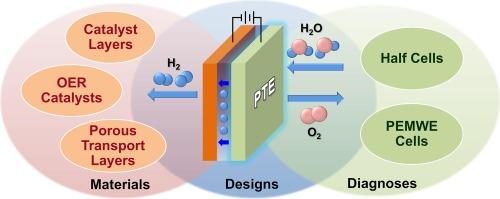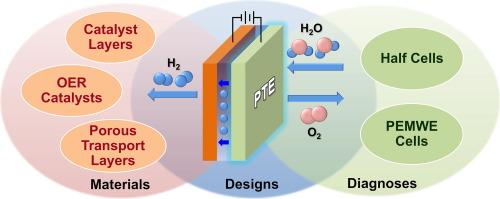质子交换膜电解池中析氧反应的多孔传输电极:材料、设计和诊断
IF 13.2
1区 工程技术
Q1 ENGINEERING, CHEMICAL
引用次数: 0
摘要
利用质子交换膜(PEM)水电解(PEMWE)电池生产氢气因其效率高且相关过程无有害排放物而受到广泛关注。在PEMWE电池中,多孔传输电极(pte)由O2析出反应(OER)催化剂组成的催化剂层(CL)、多孔传输层(PTL)和PEM对电池的性能和寿命起着关键作用。本文综述了在低pH值和高阳极电位下具有高活性和稳定性的ir基和非贵金属OER催化剂,以了解它们的OER机制。为工程CLs和ptl提出了各种策略,以改善活性位点之间的界面性质和反应物和产物的传质。此外,pte的诊断对于解释电化学过程和解决当前的挑战至关重要。因此,我们探索了包括扩散电极(DE)、浮动电极(FE)和改良旋转圆盘电极(MRDE)在内的半电池分析技术,并建立了基于膜电极组装(MEA)的分析技术,如极化技术、电化学阻抗谱和磁场分析。本研究旨在概述用于PEMWE电池工程和诊断工具的最新技术,并对该领域即将开发的先进组件和系统进行深入研究。本文章由计算机程序翻译,如有差异,请以英文原文为准。


Porous transport electrodes for oxygen evolution reaction in proton exchange membrane water electrolysis -cells: Materials, designs, and diagnoses
H2 production using proton exchange membrane (PEM) water electrolysis (PEMWE) cells has received considerable attention because of the high efficiencies of these cells and no harmful emissions from the related process. In PEMWE cells, porous transport electrodes (PTEs) composed of a catalyst layer (CL) comprising O2 evolution reaction (OER) catalysts, porous transport layer (PTL), and PEM play key roles in the stack performance and lifetime. Herein, Ir-based and non-precious-metal OER catalysts that are highly active and stable at low pH values and high anodic potentials are reviewed to understand their OER mechanisms. Various strategies are proposed for engineering CLs and PTLs to improve the interfacial properties and mass transfers of reactants and products to and from the active sites. Additionally, diagnoses of PTEs is significantly crucial for interpreting electrochemical processes and addressing their current challenges. Therefore, half-cell analyses, including diffusion electrode (DE), floating electrode (FE), and modified rotating disk electrode (MRDE) techniques, are explored, and membrane electrode assembly (MEA)-based analyses, such as the polarization technique, electrochemical impedance spectroscopy, and magnetic field analysis, are established. This study aims to provide an overview of recent technologies used for the engineering and diagnostic tools of PEMWE cells and insights into the advanced components and systems to be developed in this field.
求助全文
通过发布文献求助,成功后即可免费获取论文全文。
去求助
来源期刊

Chemical Engineering Journal
工程技术-工程:化工
CiteScore
21.70
自引率
9.30%
发文量
6781
审稿时长
2.4 months
期刊介绍:
The Chemical Engineering Journal is an international research journal that invites contributions of original and novel fundamental research. It aims to provide an international platform for presenting original fundamental research, interpretative reviews, and discussions on new developments in chemical engineering. The journal welcomes papers that describe novel theory and its practical application, as well as those that demonstrate the transfer of techniques from other disciplines. It also welcomes reports on carefully conducted experimental work that is soundly interpreted. The main focus of the journal is on original and rigorous research results that have broad significance. The Catalysis section within the Chemical Engineering Journal focuses specifically on Experimental and Theoretical studies in the fields of heterogeneous catalysis, molecular catalysis, and biocatalysis. These studies have industrial impact on various sectors such as chemicals, energy, materials, foods, healthcare, and environmental protection.
 求助内容:
求助内容: 应助结果提醒方式:
应助结果提醒方式:


